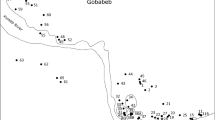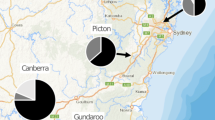Summary
The genetic population structure and the sociogenetic organization of the red wood ant Formica truncorum were compared in two populations with monogynous colonies and two populations with polygynous colonies. The genetic population structure was analysed by measuring allele frequency differences among local subsets of the main study populations. The analysis of sociogenetic organisation included estimates of nestmate queen and nestmate worker relatedness, effective number of queens, effective number of matings per queen, relatedness among male mates of nestmate queens and relatedness between queens and their male mates. The monogynous populations showed no differentiation between subpopulations, whereas there were significant allele frequency differences among the subpopulations in the polygynous population. Workers, queens and males showed the same genetical population structure. The relatedness among nestmate workers and among nestmate queens was identical in the polygynous societies. In three of the four populations there was a significant heterozygote excess among queens. The queens were related to their male mates in the polygynous population analysed, but not in the monogynous ones. The data suggest limited dispersal and partial intranidal mating in the populations with polygynous colonies and outbreeding in the populations having monogynous colonies. Polyandry was common in both population types; about 50% of the females had mated at least twice. The males contributed unequally to the progeny, one male fathering on average 75% of the offspring with double mating and 45–80% with three or more matings.
Similar content being viewed by others
References
Boomsma JJ, Grafen A (1990) Intraspecific variation in ant sex ratios and the Trivers-Hare hypothesis. Evolution 44:1026–1034
Boomsma JJ, Grafen A (1991) Colony-level sex ratio selection in the eusocial Hymenoptera. J Evol Biol 3:383–407
Cherix D, Chautems D, Fletcher DJC, Fortelius W, Gris G, Keller L, Passera L, Rosengren R, Vargo EL, Walther F (1991) Alternative reproductive strategies in Formica lugubris Zett. (Hymenoptera: Formicidae). Ethol Ecol Evol 1:61–66
Collingwood CA (1979) The Formicidae (Hymenoptera) of Fennoscandia and Denmark. Fauna Entomol Scand 8:1–174
Craig R, Crozier RH (1979) Relatedness in the polygynous ant Myrmecia pilosula. Evolution 33:335–341
Crozier RH, Consul PC (1976) Conditions for genetic polymorphism in social Hymenoptera under selection at the colony level. Theor Pop Biol 10:1–9
Crozier RH, Page RE Jr (1985) On being the right size: male contributions and multiple mating in social Hymenoptera. Behav Ecol Sociobiol 18:105–115
Douwes P, Sivusaari L, Niklasson M, Stille B (1987) Relatedness among queens in polygynous nests of the ant Leptothorax acervorum. Genetica 75:23–29
Elmes GW (1980) Queen numbers in colonies of the ants of the genus Myrmica. Insectes Soc 27:43–60
Fortelius W (1987) Different patterns of female behaviour in mono-and polydomous Formica populations. In: Eder J, Remboldt H (eds) Chemistry and biology of social insects. Peperny, München, pp 293–294
Fortelius W, Rosengren, R, Cherix, D Chautems, D (1993) Queen recruitment in a highly polygynous supercolony of Formica lugubris (Hymenoptera; Formicidae). Oikos 67:193–200
Goodnight K (1992) The effect of stochastic variation on kin selection in a budding viscous population. Am Nat 6:1028–1040
Hamilton WD (1964) The genetical evolution of social behaviour. J Theor Biol 7:1–52
Hamilton WD (1987) Kinship, recognition, disease, and intelligence: constraints of social evolution. In: Itô Y, Brown JL, Kikkava J (eds) Animal societies: theories and facts. Japan Scientific Societies, Tokyo, pp 81–102
Have T van der, Boomsma JJ, Menken SBJ (1988) Sex investment ratios and relatedness in the monogynous ant Lasius niger (L.). Evolution 42:160–170
Heinze J, Lipski N, Hölldobler B (1992) Reproductive competition in colonies of the ant Leptothorax gredleri. Ethology 90:265–278
Hölldobler B, Wilson EO (1977) The number of queens: an important trait in ant evolution. Naturwissenschaften 65:8–15
Hölldobler B, Wilson EO (1990) The ants. Springer, Berlin Heidelberg New York
Keller L, Cherix D, Ulloa-Chacon P (1989) Description of a new artificial diet for rearing ant colonies as Iridomyrmex humilis, Monomorium pharaonis and Wasmannia auropunctata (Hymenoptera: Formicidae). Insectes Soc 36:348–352
Li CC Horwitz DG (1953) Some methods of estimating the inbreeding coefficient. A. J Hum Genet 5:107–117
Moritz RFA (1985) The effects of multiple mating on the worker-queen conflict in Apis mellifera L. Behav Ecol Sociobiol 16:375–377
Moritz RFA, Southwick EE (1987) Phenotype interactions in group behaviour of honey bee workers (Apis mellifera L.). Behav Ecol Sociobiol 21:53–57
Nei M (1987) Molecular evolutionary genetics. Columbia University Press, New York
Nonacs P (1988) Queen number in colonies of social Hymenoptera as a kin-selected adaptation. Evolution 42:566–580
Nonacs P (1992) Male parentage and sexual deception in the social Hymenoptera. In: Wrensch DL, Ebbert MA (eds) Evolution and diversity of sex ratio in insects and mites. Chapman and Hall, New York
Page RE Jr (1980) The evolution of multiple mating behaviour by honey bee queens (Apis mellifera L.). Genetics 96:263–273
Page RE Jr (1986) Sperm utilization in social insects. Annu Rev Entomol 31:297–320
Page RE Jr, Robinson GE, Calderone NW, Rothenbuhler WC (1989) Genetic structure, division of labor and the evolution of insect societies. In: Page RE, Breed MD (eds) The genetics of social insects. Westview, Boulder, pp 15–29
Pamilo P (1981) Genetic organization of Formica sanguinea populations. Behav Ecol Sociobiol 9:45–50
Pamilo P (1982a) Multiple mating in Formica ants. Hereditas 97:37–45
Pamilo P (1982b) Genetic population structure in polygynous Formica ants. Heredity 48:95–106
Pamilo P (1983) Genetic differentiation within subdivided populations of Formica ants. Evolution 37:1010–1022
Pamilo P (1989) Estimating relatedness in social groups. Trends Ecol Evol4:353–355
Pamilo P (1990a) Sex allocation and queen-worker conflict in polygynous ants. Behav Ecol Sociobiol 27:31–36
Pamilo P (1990b) Comparison of relatedness estimators. Evolution 44:1378–1382
Pamilo, P (1991a) Life span of queens in the ant Formica exsecta. Insectes Soc 38:111–120
Pamilo P (1991b) Evolution of colony characteristics in social insects 1. Sex allocation. Am Nat 137:83–107
Pamilo P (1991c) Evolution of colony characteristics in social insects 2. Number of reproductive individuals. Am Nat 138:412–433
Pamilo P (1993) Polyandry and allele frequency differences between the sexes in the ant Formica aquilonia. Heredity 70:472–480
Pamilo P, Crozier R (1982) Measuring genetic relatedness in natural populations: methodology. Theor Pop Biol 21:171–193
Pamilo P, Rosengren R (1984) Evolution of nesting strategies of ants: genetic evidence from different population types of Formica ants. Biol J Linn Soc 21:331–348
Pamilo P, Varvio-Aho S (1979) Genetic structure of nests in the ant Formica sanguinea. Behav Ecol Sociobiol 6:91–98
Pamilo P, Vepsäldinen K, Rosengren R, Varvio-Aho S-L, Pisarski B (1979) Population genetics of Formica ants II. Genetic differentiation between species. Ann Entomol Fenn 45:65–76
Pearson B (1982) Relatedness of normal queens (macrogynes) in nests of the polygynous ant Myrmica rubra Latreille. Behav Ecol Sociobiol 12:1–4
Queller DC, Goodnight KIT (1989) Estimating relatedness using genetic markers. Evolution 43:258–275
Ratnieks FLW (1988) Reproductive harmony via mutual policing by workers in eusocial Hymenoptera. Am Nat 132:217–236
Ratnieks FLW (1990) The evolution of polyandry by queens in social Hymenoptera: the significance of timing of removal of diploid males. Behav Ecol Sociobiol 26:343–348
Rosengren R, Pamilo P (1983) Sex ratio strategy as related to queen number, dispersal behviour and habitat quality in Formica ants (Hymenoptera: Formicidae). Entomol Gen 11:139–151
Rosengren R, Cherix D, Pamilo P (1985) Insular ecology of the red wood ant Formica truncorum Fabr. 1. Polydomous nesting, population size and foraging. Mitt Schweiz Ges 58:147–175
Rosengren R, Cherix D, Pamilo P (1986) Insular ecology of the red wood ant Formica truncorum Fabr. 2. Distribution, reproductive strategy and competition. Mitt Schweiz Ges 59:63–94
Rosengren R, Sundström L, Fortelius W (1993) Monogyny and polygyny of Formica ants — a result of different dispersal tactics? In: Keller L (ed) Queen number and sociality in insects. Oxford University Press, Oxford
Ross KG (1986) Kin selection and the problem of sperm utilization in social insects. Nature 323:798–800
Ross KG (1988) Differential reproduction in multiple-queen colonies of the fire ant Solenopsis invicta (Hymenoptera; Formicidae). Behav Ecol Sociobiol 23:341–355
Ross KG (1993) The breeding system of the fire ant Solenopsis invicta: effects on colony genetic structure. Am Nat 141:554–576
Ross KG, Fletcher DJC (1986) Diploid male production — a significant colony mortality factor in the fire ant Solenopsis invicta (Hymenoptera: Formicidae). Behav Ecol Sociobiol 19:283–291
Ross KG, Vargo, EL, Fletcher DJC (1988) Colony genetic structure and queen mating frequency in fire ants of the subgenus Solenopsis (Hymenoptera: Formicidae). Biol J Linn Soc 34:105–117
Seppä P (1992) Genetic relatedness of worker nestmates in Myrmica ruginodis (Hymenoptera: Formicidae) populations. Behav Fool Sociobiol 30:253–260
Seppä P (1993) Sociogenetic organization of Myrmica ruginodis and Myrmica lobicornis (Hymenoptera: Formicidae) colonies and populations: number, relatedness and longevity of reproducing individuals. J Evol Biol, in press
Sherman PW, Seeley TD, Reeve HK (1988) Parasites, pathogens, and polyandry in social Hymenoptera. Am Nat 131:602–610
Starr CK (1984) Sperm competition, kinship and sociality in the aculeate Hymenoptera. In: Smith RL (ed) Sperm competition and the evolution of animal mating systems. Academic, New York, pp 427–464
Stille M, Stille B, Douwes P, (1991) Polygyny, relatedness and nest founding in the polygynous myrmicine ant Leptothorax acervorum (Hymenoptera; Formicidae). Behav Ecol Sociobiol 28:91–96
Sundström L (1989) Genetic relatedness and population structure in Formica truncorum Fabr. (Hymenoptera: Formicidae). Actes Coll Ins Soc 5:93–100
Taylor P (1992) Altruism in viscous populations — an inclusive fitness model. Evol Ecol 6:352–356
Trivers RL, Hare H (1976) Haplodiploidy and the evolution of the social insects. Science 191:249–263
Wahlund S (1928) Zusammensetzung von Populationen und Korrelationserscheinungen vom Standpunkt der Vererbungslehre ausbetrachtet. Hereditas 11:65–106
Wilson DS (1980) The natural selection of populations and communities. Benjamin/Cummings, Menlo Park
Woyciechovski M, Lomnicki A (1987) Multiple mating of queens and the sterility of workers among eusocial Hymenoptera. J Theor Biol 128:317–327
Wright S (1931) Evolution in Mendelian populations. Genetics 97–159
Wright S (1940) Breeding structure of populations in relation to speciation. Am Nat 74:232–248
Wright S (1943) Isolation by distance. Genetics 28:114–138
Wright S (1951) The genetical structure of populations. Ann Eugenics 15:323–354
Yarrow IHH (1955) The British ants allied to Formica rufa L. (Hym; Formicidae). Trans Soc Br Entomol 12:1–48
Author information
Authors and Affiliations
Additional information
Correspondence to: L. Sundström
Rights and permissions
About this article
Cite this article
Sundström, L. Genetic population structure and sociogenetic organisation in Formica truncorum (Hymenoptera; Formicidae). Behav Ecol Sociobiol 33, 345–354 (1993). https://doi.org/10.1007/BF00172934
Received:
Accepted:
Issue Date:
DOI: https://doi.org/10.1007/BF00172934




